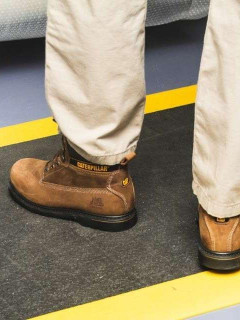For most consumers, the smartphone is the most important channel used in the orientation phase of a purchase. But does this also apply in a business-to-business (or B2B) environment? In a recent survey of RAJA Group‘s European customers, the B2B use of a business smartphone was examined in detail. What did we find out? In B2B purchasing behaviour, it is increasingly common to search for information via a smartphone and to purchase products on the move. You can find all the results below.
1. B2B customers and their general mobile usage
De tous les pays examinés, c’est au Danemark que le taux d’utilisation des smartphones professionnels est le plus élevé. Cela place les Danois à l’avant-garde de pays comme l’Espagne et le Royaume-Uni ; des pays qui sont souvent considérés comme des leaders dans l’utilisation des appareils mobiles. La consommation quotidienne en France, en revanche, est bien en dessous de la moyenne européenne.
Dans tous les pays, le smartphone est le plus consulté pendant les pauses quotidiennes (par exemple pendant le déjeuner ou la pause-café). En Norvège et en Allemagne, nous voyons encore d’autres résultats remarquables : une partie considérable des personnes interrogées ont également consulté leur smartphone le soir à des fins professionnelles. Les Suédois et les Polonais, par contre, utilisent leurs smartphones beaucoup plus souvent lorsqu’ils voyagent (par exemple pendant des voyages d’affaires).

2. What influence does the smartphone have on B2B buying behaviour?
B2B buyers use their smartphones mainly to gather or check information.They do this by browsing the websites of manufacturers or partners, for example.In Denmark and Germany, it appears that information is often obtained from specialised media and blogs.This has a significant impact on B2B buying behaviour.In other words, existing customers or prospects are already very well informed when they get in touch with a salesperson.
In Spain and Denmark, social media are most often consulted.LinkedIn, in particular, stands out then.The majority of Spaniards and Danes use this tool to search for professional information.
3. What are the essential features of a mobile website?
Among the respondents, there was one answer that stands out. The most important feature of a mobile website for them is the presence of a search function. An intelligent and efficient search function saves the user a lot of time and frustration. Other points were also mentioned
- The ability to simply add products to the shopping cart based on products already purchased.
- The ability to have an overview of the purchase history.
- The ability to maintain a wish list and complete a purchase at a later date.
did you know that Rajapack also has a mobile website? Watch the video below and discover all the features of our new mobile website:
4. M-commerce in the B2B sector
When it comes to business purchases on a mobile website (or m-commerce), we see that Spain is at the top of the league. Most respondents indicated that they had made a mobile purchase for their employer in the last 6 months. In countries such as France or Norway, these figures were lower.
These buyers made an average of at least two purchases on their smartphone in the last six months. No big surprise: B2B employees who are often on the road choose to buy via their smartphone or tablet. Because they don’t have access to a desktop or laptop, a smartphone/tablet is the most obvious alternative














